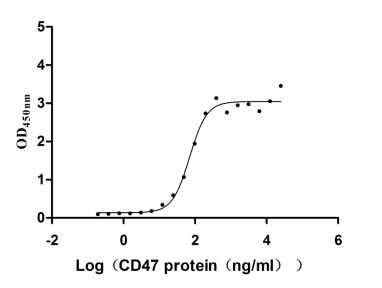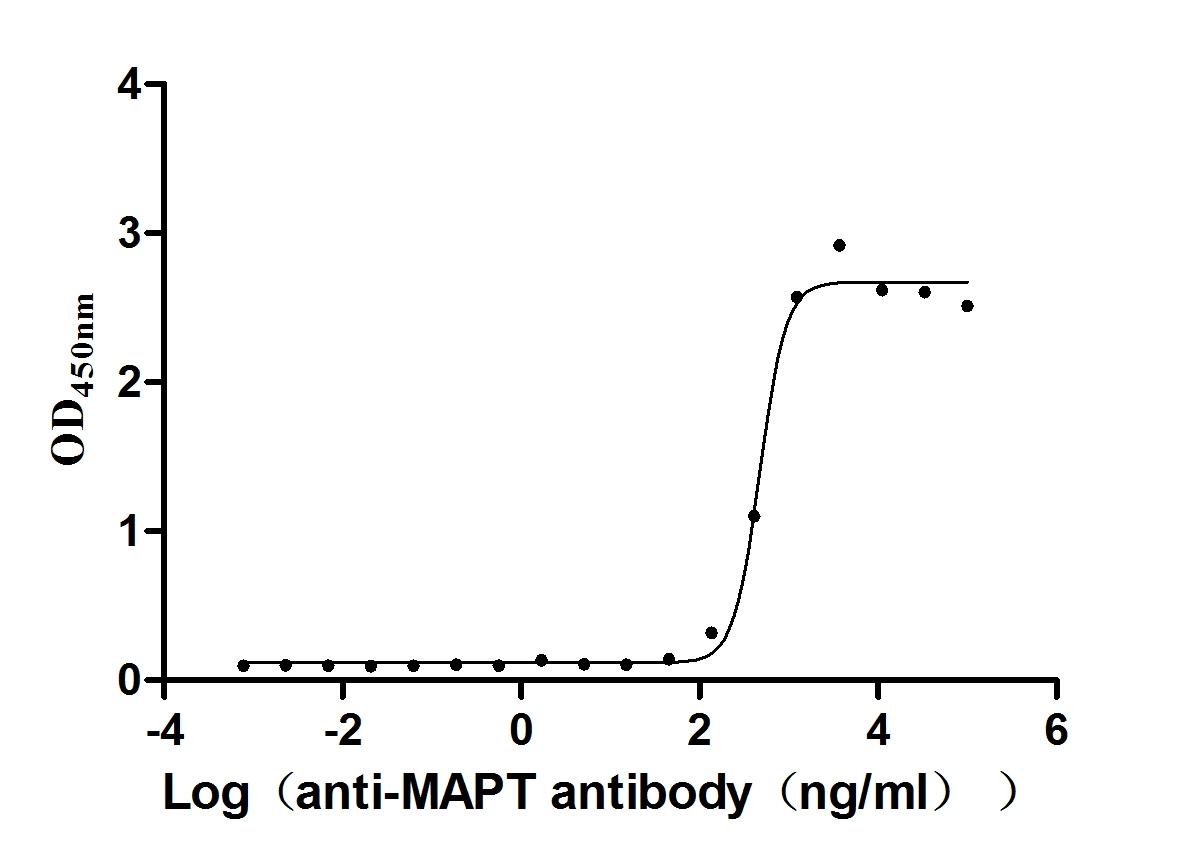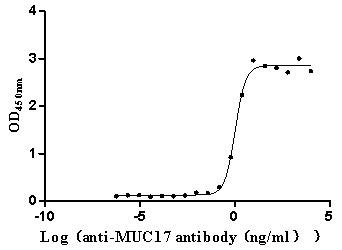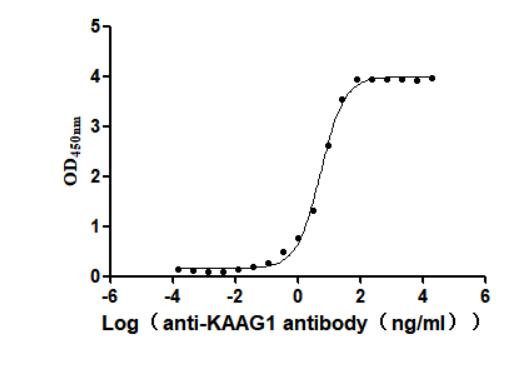Recombinant Human Heat shock protein beta-6 (HSPB6)
-
中文名称:人HSPB6重组蛋白
-
货号:CSB-YP010837HU
-
规格:
-
来源:Yeast
-
其他:
-
中文名称:人HSPB6重组蛋白
-
货号:CSB-EP010837HU
-
规格:
-
来源:E.coli
-
其他:
-
中文名称:人HSPB6重组蛋白
-
货号:CSB-EP010837HU-B
-
规格:
-
来源:E.coli
-
共轭:Avi-tag Biotinylated
E. coli biotin ligase (BirA) is highly specific in covalently attaching biotin to the 15 amino acid AviTag peptide. This recombinant protein was biotinylated in vivo by AviTag-BirA technology, which method is BriA catalyzes amide linkage between the biotin and the specific lysine of the AviTag.
-
其他:
-
中文名称:人HSPB6重组蛋白
-
货号:CSB-BP010837HU
-
规格:
-
来源:Baculovirus
-
其他:
-
中文名称:人HSPB6重组蛋白
-
货号:CSB-MP010837HU
-
规格:
-
来源:Mammalian cell
-
其他:
产品详情
-
纯度:>85% (SDS-PAGE)
-
基因名:HSPB6
-
Uniprot No.:
-
别名:epididymis luminal protein 55; FLJ32389; Heat shock 20 kDa like protein p20 ; Heat shock 20 kDa-like protein p20; Heat shock protein alpha crystallin related B6; Heat shock protein beta 6 ; Heat shock protein beta-6; Heat shock protein; 20-KD; Heat-shock 27-KD protein 6; HEL55; Hsp20; HspB6; HSPB6_HUMAN
-
种属:Homo sapiens (Human)
-
蛋白长度:Full length protein
-
表达区域:1-160
-
氨基酸序列MEIPVPVQPS WLRRASAPLP GLSAPGRLFD QRFGEGLLEA ELAALCPTTL APYYLRAPSV ALPVAQVPTD PGHFSVLLDV KHFSPEEIAV KVVGEHVEVH ARHEERPDEH GFVAREFHRR YRLPPGVDPA AVTSALSPEG VLSIQAAPAS AQAPPPAAAK
-
蛋白标签:Tag type will be determined during the manufacturing process.
The tag type will be determined during production process. If you have specified tag type, please tell us and we will develop the specified tag preferentially. -
产品提供形式:Lyophilized powder
Note: We will preferentially ship the format that we have in stock, however, if you have any special requirement for the format, please remark your requirement when placing the order, we will prepare according to your demand. -
复溶:We recommend that this vial be briefly centrifuged prior to opening to bring the contents to the bottom. Please reconstitute protein in deionized sterile water to a concentration of 0.1-1.0 mg/mL.We recommend to add 5-50% of glycerol (final concentration) and aliquot for long-term storage at -20℃/-80℃. Our default final concentration of glycerol is 50%. Customers could use it as reference.
-
储存条件:Store at -20°C/-80°C upon receipt, aliquoting is necessary for mutiple use. Avoid repeated freeze-thaw cycles.
-
保质期:The shelf life is related to many factors, storage state, buffer ingredients, storage temperature and the stability of the protein itself.
Generally, the shelf life of liquid form is 6 months at -20°C/-80°C. The shelf life of lyophilized form is 12 months at -20°C/-80°C. -
货期:Delivery time may differ from different purchasing way or location, please kindly consult your local distributors for specific delivery time.Note: All of our proteins are default shipped with normal blue ice packs, if you request to ship with dry ice, please communicate with us in advance and extra fees will be charged.
-
注意事项:Repeated freezing and thawing is not recommended. Store working aliquots at 4°C for up to one week.
-
Datasheet :Please contact us to get it.
相关产品
靶点详情
-
功能:Small heat shock protein which functions as a molecular chaperone probably maintaining denatured proteins in a folding-competent state. Seems to have versatile functions in various biological processes. Plays a role in regulating muscle function such as smooth muscle vasorelaxation and cardiac myocyte contractility. May regulate myocardial angiogenesis implicating KDR. Overexpression mediates cardioprotection and angiogenesis after induced damage. Stabilizes monomeric YWHAZ thereby supporting YWHAZ chaperone-like activity. ...显示更多
-
基因功能参考文献:
- Structural basis for the interaction of a human HSPB6 protein with the 14-3-3 universal signaling regulator has been reported. PMID: 28089448
- Data suggest that HSPB6 forms hetero-oligomers with HSPB1 under the following rules: (1) highly conserved motif RLFDQXFG is necessary for subunit exchange among oligomers, (2) a site about 20 residues downstream of this motif determines size of resultant hetero-oligomers, and (3) a region in the N-terminal domain that is unique to HSPB6 dictates preferential formation of heterodimers. (HSP = heat shock protein) PMID: 28487364
- findings strongly suggest that phosphorylated HSP20 inhibits TGF-alpha-induced HCC cell migration and invasion via suppression of the JNK signaling pathway PMID: 27046040
- multiple sclerosis lesions revealed exclusive induction of HSPB6 in astrocytes, as confirmed by co-localization of HSPB6 with GFAP. PMID: 26694816
- N-terminal mutations increase stability of large HspB1 homooligomers, prevent their phosphorylation-dependent dissociation, modulate their interaction with HspB6 and decrease their chaperoning capacity, preventing normal functioning of HspB1. PMID: 25965061
- Findings strongly suggest that HSP20 directly associates with Bax and stimulates caspase cascade in human hepatocellular carcinoma cells. PMID: 24969689
- Data suggest that heat shock protein 20 (HSP20) may have value as a prognostic tumor marker and its overexpression might be a novel strategy for colorectal cancer (CRC) therapy. PMID: 25187324
- peptides in heat-shock protein Hsp20 (G71HFSVLLDVKHFSPEEIAVK91) and Hsp27 (D93RWRVSLDVNHFAPDELTVK113) with sequence homology to alpha-crystallin also have robust chaperone and anti-apoptotic activities. PMID: 25332102
- These findings strongly suggest that HSP20 might decrease the IKK-alpha protein level and that it down-regulates the TNF-alpha-stimulated intracellular signaling in HCC, thus resulting in the suppression of HCC progression. PMID: 25447820
- HSP20 may play a protective role against the progression of ovarian cancer. PMID: 25423708
- HSP20 directly associates with PI3K subunits and suppresses its activity in hepatocellular carcinoma, resulting in the inhibition of the AKT pathway, and subsequently decreasing the growth of hepatocellular carcinoma. PMID: 24223153
- 14-3-3zeta and possibly other 14-3-3 isoforms may have additional functional roles conducted by the monomeric state PMID: 22794279
- the cytosolic protein AKAP-Lbc (AKAP13) as the anchoring protein responsible for directing PKA phosphorylation of Hsp20 on Ser(16) PMID: 22731613
- Hsp20 serves as a novel cardiokine in regulating myocardial angiogenesis through activation of the VEGFR signaling cascade. PMID: 22427880
- cofilins 1 and 2 only weakly interact with 14-3-3 and therefore cannot directly compete with phosphorylated small heat shock protein HspB6 for its binding to 14-3-3 PMID: 22450169
- Properties of the monomeric form of 14-3-3zeta protein and its interaction with tau and HspB6. This interaction requires phosphorylation of tau protein and HspB6. PMID: 21978388
- A potential molecular mechanism by which Hsp20 acetylation can affect myometrial activity by liberating cofilin PMID: 21803775
- Overexpression of HSPB1, as well as HSPB6, HSPB7 and HSPB8 independently protect against tachycardia remodeling by attenuation of the RhoA GTPase pathway at different levels. PMID: 21731611
- Nevertheless, in solution, both alpha-crystallin domain proteins form stable dimers via the symmetric antiparallel interaction of beta7 strands. PMID: 21641913
- The 14-3-3 zeta mutation mimicking phosphorylation of Ser184 does not markedly affect interaction with tau protein and improves the interaction of 14-3-3 zeta with HspB6. PMID: 21081103
- Data show that the interaction between HspB6 and Bag3 requires the same regions that are involved in the HspB8-Bag3 association. PMID: 19845507
- Our results suggest that a variety of oligomers composed of different proportions of different sHSPs may form in cell types expressing multiple sHSPs. PMID: 16225851
- Phosphorylation led to changes in actin cytoskeletal morphology in 3T3 cells, delineating strategies for the expression and activation of therapeutic molecules for intracellular protein based therapeutics. PMID: 17084643
- Interaction of human 14-3-3gamma with the small heat shock protein Hsp20 was analyzed by means of size-exclusion chromatography and chemical crosslinking. PMID: 17109079
- Data support a novel role for pHSP20 in the modulation of cyclic-nucleotide-mediated myometrial relaxation, through interaction with actin. pHSP20 represents an important new target for future tocolytic therapy. PMID: 18755793
- AZX100, an analogue of the small heat shock protein, HSP20, reduces TGF-beta1-induced CTGF expression in keloid fibroblasts PMID: 18787533
- Human mutation in the anti-apoptotic heat shock protein 20 abrogates its cardioprotective effects PMID: 18790732
- Here, crystal structures of excised alpha-crystallin domain from rat Hsp20 and that from human alphaB-crystallin show that they form homodimers with a shared groove at the interface by extending a beta sheet. PMID: 19646995
- Report increased levels of phosphorylated Hsp20 in failing hearts. PMID: 19850943
收起更多
-
亚细胞定位:Cytoplasm. Nucleus. Secreted.
-
蛋白家族:Small heat shock protein (HSP20) family
-
数据库链接:
HGNC: 26511
OMIM: 610695
KEGG: hsa:126393
STRING: 9606.ENSP00000004982
UniGene: Hs.534538




















